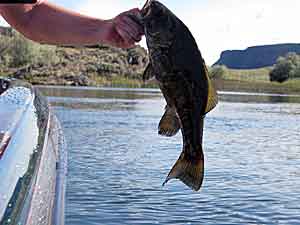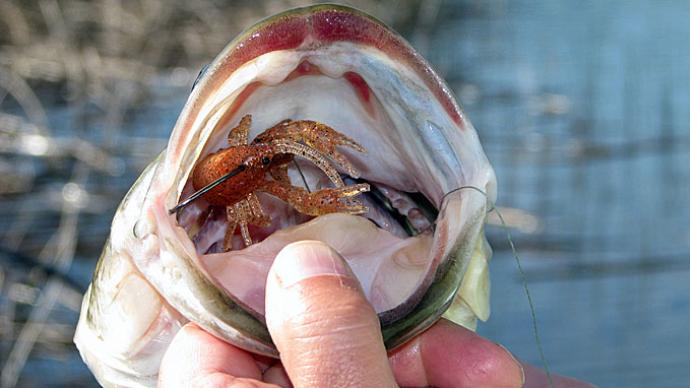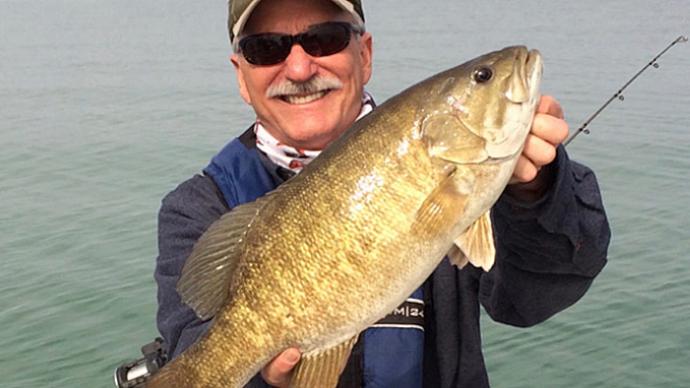
For many fishermen, the bass fishing season ends right after Labor Day. On the other hand, diehard bass fishermen know that some of the best bass fishing of the year will follow.
As the cool nights turn the leaves different colors, the cool nip in the air will signal a change. The shorter days of sunlight will drop the water temperature the lake has held all summer long. Following the downward mark of the water temperature will come fall turnover. The cooling upper layer of water will become heavier than the water underneath, causing it to sink, pushing the warmer water to the surface. This marks the start of the fall turnover event. The process will generally last about ten to fourteen days, depending on weather conditions during that period.
If you want to take advantage of these different stages, you have to pay attention to what is going on with the lake and the bass. Before fall turnover started, bass could feel the change of the falling lake temperature and started to hit the shallows to take advantage of the abundant food sources making the shift and putting on the feed bag to fatten up for the upcoming winter period.
To prepare for the upcoming changes, almost all of the lake's fish population will be drawn towards the shallows during the early fall months. When the bass hit the shallows, they will be looking for an external food source. Bluegills and craws will pretty much fill this bill as they did in the deeper water depths during the summer months. In early fall, frogs making their way back to the lakes to hibernate will take center stage for a few weeks.
During the first few weeks of the fall period, bass will be on the roam, and you will have to cover water to stay with them. For these times, you should throw a lot of baits like shallow cranks, traps, and spinnerbaits. All these baits get a lot of water time in the first month. After the turnover, fish will move into deeper water, so deep diving crankbaits and jig-n-pig combos come into play.
Shallow Crankbaits
Shallow and mid-depth cranks are the two that will get the most attention in the early part of the fall season when the bass are making their way into the shallows. Rapala's DT Fats 1 and 3, Storms Sub Wart, and Mid Warts are the perfect baits to have on your line at this time of the season. Long casts and contact with the weeds are vital to getting and triggering bites. You want a bait that will tick the weeds on the retrieve and not get hung up, so pick your baits to fit the depth of water you're fishing. Shallow cranks are a great choice to imitate bluegills and craws swimming around in the shallows at this season.
Traps and Spinnerbaits
These two baits fall almost into the same class. These bait choices shine when the bass are located on the weed flats. The shallow cranks, traps, and spinnerbaits excel in getting bites when they contact the weeds. Spinnerbaits will be easier to work when the weeds are thicker, but if the weeds are sparse, it seems the trap will perform better as the bait's action is more erratic.
Let's start with spinnerbaits. For the fall, I make a few modifications to my baits. For one, I use a trailer. I generally use a twister tail for this, or I'll use a Bass Pro Cajun Trailer. This bulks up the bait, allowing you to work it slower. I'll often use a double willow combination instead of a single Colorado-bladed bait. This again is a speed factor. I can work the double willow slower than a Colorado-bladed bait, which keeps it in the bass zone longer.
If it's traps I'm fishing, I'll generally use them in a little deeper water out on the flats, targeting more of the weed clumps than the solid weeds. Making weed contact is more critical when fishing the trap than fishing shallow cranks or the spinnerbait. Part of what makes the bass attack this bait is when it's ripped off the weeds. I feel this is what triggers many of the strikes.
I make my cast and reel the trap back to the boat. When the bait makes contact with the weeds, I give the rod a good pull to break the bait free of the weeds and get it on its way again. This is generally the time that I'll get the strike. A delicate balance triggers this pattern of fishing. If I'm in too thick of weeds, I won't be able to fish the trap properly, getting hung up all the time. On the other side of the coin, I don't have the trigger to get many bites if I'm not contacting the weeds.
All three of these baits make great choices before fall turnover when the weeds are still alive and green. After fall turnover, the lake's shallow weeds will start to die off, pushing the bass and the significant fish population deeper. When this change occurs, you will have to move with the bass to catch them again. For this, you will need to reload and make adjustments. The key now will be deeper green weeds on the deep flats and the edges. When we get to this time of the year, we are talking schools of bass again, not a bass here or there like fishing in the early part of the fall season.
Deep green weeds are critical during the season and will become the attraction of later fall bass. These deeper green weeds will still give off oxygen, attracting bass and other gamefish. To find these green weeds, you can't beat a deeper diving crankbait.
Deep Crankbaits
I'll use a Storm Magnum Wiggle Wart or a Bomber Fat-Free Shad for this tactic. When fishing this tactic, these baits have wide wobble actions and will shed the weeds better than other baits. The keys to fishing these baits during the fall bite are boat position and making pinpoint casts to the weed edge. Just as in fishing a trap, you have to contact the weeds with your crankbait. Boat position will play a big part in having your crankbait tick the weeds or getting it hung up. Position your boat out far enough to be able to cast to the weed edge and not too far on top of the weeds. When you feel the bait tick the weeds, give the rod a good pull like you're setting the hook to get the bait on its way again. This is generally when you will get the bites.
Jig-n-Pig
Once I have found a few active bass with the cranks, I'll change to a jig combination to get the rest to bite. There is something about fall and a jig that seem to go together. It's been said many times if you're looking for one bait to fish during the late fall months, it has to be a jig. I fully agree with that statement. Now, don't get me wrong. There will be days that you will catch bass on the deep crankbait tactic I just covered, but when one adds up all the numbers at the end of the season, the jig will have caught more bass than the crankbait.
When it comes to jig sizes, you will have to carry a few different sizes to fit the fishing conditions. The main sizes of Outkast Jigs that I carry are 3/8, 1/2, and 3/4 ounce. I use 3/8 ounce when fishing in calmer wind conditions or when the bite gets tough. I would say that I use a 1/2 ounce Pro Staff Outkast Jig for most of my fall bass fishing. I use a 3/4 ounce Pro Staff Outkast Jig for high wind conditions.
For the trailer (the "pig" part of the jig), I always carry a few different options to play with, and I let the bass tell me what they want. Outkast Chunks, Craws, and Fat Tail Grubs pretty much fill out what I use during the fall months. I'll generally start with the Outkast Chuck and switch from there until I find what the bass want for the day.
Try a Texas rigged tube or tube craw presentation if you're looking for a sleeper bait to use at the end of the season. I feel that when the bass get touchy and have a tendency to spit out a jig before you can get a good hook set, it's time to put down the jig and pick up the Texas rigged tube. When the bass pick up the tube and bite down, they don't seem to drop this bait as fast, allowing a good hook set. I feel this is due to one factor that when they bite down on the tube, it makes the bass think it's something real, thus giving extra time to set the hook.
Don't give up on bass too early next fall. Some of the best bass fishing of the year is still to come. Before the turnover, shallow cranks, spinnerbaits, and traps will fill the bass fishing bill. After the turnover, deep cranks and jig-n-pig combos will take the bass later into the late fall season. Green weeds will play a big part in locating bass during the season, so pay attention to what conditions the weeds are where you're fishing. If you have not fished for late-season bass before, you may be surprised at how great the late-season bass fishing is.




